Evaluating the Effect of Deficit Irrigation on Yield and Water Use Efficiency of Drip Irrigation Cotton under Film in Xinjiang Based on Meta-Analysis
Abstract
:1. Introduction
2. Results
2.1. Overview of the Database
2.2. Effects of Different Irrigation Amounts and Drip Tape Modes on Cotton Yield and Water Use Efficiency
2.3. Effect of Different Irrigation Frequencies and Nitrogen Applications on Cotton Yield and Water Use Efficiency
2.4. Effects of Different Varieties and Planting Densities on Cotton Yield and Water Use Efficiency
2.5. Effects of Different Climatic and Soil Conditions on Cotton Yield and Water Use Efficiency
2.6. Trade-Offs between Cotton Yield and Water Use Efficiency under Deficient Irrigation and Their Key Influencing Factors
3. Discussion
3.1. The Combined Effect of Deficient Irrigation on Cotton Yield and Water Use Efficiency
3.2. Effects of Different Farm Management Practices on Cotton Yield and Water Use Efficiency
3.3. Effect of Different Climatic and Soil Conditions on Cotton Yield and Water Use Efficiency
4. Materials and Methods
4.1. Data Collection
4.2. Meta-Analysis
4.3. Publication Bias Test
4.4. Subgroup Analysis
4.5. Statistical Analysis
5. Conclusions
Supplementary Materials
Author Contributions
Funding
Data Availability Statement
Conflicts of Interest
References
- Tan, H.; Ma, Q. A tentative discussion on the constraints on production and development of cotton and countermeasures. In Proceedings of the International Conference on Frontiers in Educational Technologies and Management Sciences, London, UK, 18–20 October 2017. [Google Scholar] [CrossRef]
- Yang, Z.N.; Tang, J.J.; Yu, M.; Zhang, Y.; Abbas, A.; Wang, S.D.; Bagadeem, S. Sustainable cotton production through increased competitiveness: Analysis of comparative advantage and influencing factors of cotton production in Xinjiang, China. Agronomy 2022, 12, 2239. [Google Scholar] [CrossRef]
- Announcement of national bureau of statistics on cotton production in 2022. China Inf. News 2022. [CrossRef]
- Xu, F.P.; Li, Y.K.; Ren, S.M. Investigation and discussion of drip irrigation under mulch in Xinjiang uygur autonomous region. Trans. Chin. Soc. Agric. Eng. 2003, 19, 25–27. [Google Scholar] [CrossRef]
- Feng, L.; Dai, J.L.; Tian, L.W.; Zhang, H.J.; Li, W.J.; Dong, H.Z. Review of the technology for high-yielding and efficient cotton cultivation in the northwest inland cotton-growing region of China. Field Crops Res. 2017, 208, 18–26. [Google Scholar] [CrossRef]
- Jiang, Y. China’s water scarcity. J. Environ. Manag. 2009, 90, 3185–3196. [Google Scholar] [CrossRef]
- Liu, J.G.; Yang, H.; Gosling, S.N.; Kummu, M.; Florke, M.; Pfister, S.; Hanasaki, N.; Wada, Y.; Zhang, X.X.; Zheng, C.M.; et al. Water scarcity assessments in the past, present, and future. Earth’s Future 2017, 5, 545–559. [Google Scholar] [CrossRef] [PubMed]
- Guo, J.K.; Shi, Z.L.; He, M.Q.; Zhang, X.Q.; Zhang, A.M.; Jia, X. Development of water-saving wheat cultivars to limit water shortage in North China—A case study of Hebei Province. Chin. J. Eco-Agric. 2010, 18, 876–879. [Google Scholar] [CrossRef]
- Wang, S.C. Living with nature in harmony: Water resources problem and countermeasures in China. J. Beijing Norm. Univ. (Nat. Sci.) 2009, 35, 441–445. [Google Scholar]
- Li, F.P.; Zhang, G.X.; Dong, L.Q. Studies for impact of climate change on hydrology and water resources. Sci. Geogr. Sin. 2013, 33, 457–464. [Google Scholar] [CrossRef]
- Yu, L.Y.; Zhao, X.N.; Gao, X.D.; Siddique, K.H.M. Improving/maintaining water-use efficiency and yield of wheat by deficit irrigation: A global meta-analysis. Agric. Water Manag. 2020, 228, 105906. [Google Scholar] [CrossRef]
- Li, M.N.; Zhang, Y.L.; Ma, C.Z.; Sun, H.R.; Ren, W.; Wang, X.G. Maximizing the water productivity and economic returns of alfalfa by deficit irrigation in China: A meta-analysis. Agric. Water Manag. 2023, 287, 108454. [Google Scholar] [CrossRef]
- Zhang, D.M.; Luo, Z.; Liu, S.H.; Li, W.J.; Tang, W.; Dong, H.Z. Effects of deficit irrigation and plant density on the growth, yield and fiber quality of irrigated cotton. Field Crops Res. 2016, 197, 1–9. [Google Scholar] [CrossRef]
- Hou, X.H.; Fan, J.L.; Hu, W.H.; Zhang, F.C.; Yan, F.L.; Xiao, C.; Li, Y.P.; Cheng, H.L. Optimal irrigation amount and nitrogen rate improved seed cotton yield while maintaining fiber quality of drip-fertigated cotton in northwest China. Ind. Crops Prod. 2021, 170, 113710. [Google Scholar] [CrossRef]
- He, P.R.; Yu, S.E.; Zhang, F.C.; Ma, T.; Ding, J.H.; Chen, K.W.; Chen, X.; Dai, Y. Effects of soil water regulation on the cotton yield, fiber quality and soil salt accumulation under mulched drip irrigation in southern Xinjiang, China. Agronomy 2022, 12, 1246. [Google Scholar] [CrossRef]
- Wang, H.D.; Wu, L.F.; Cheng, M.H.; Fan, J.L.; Zhang, F.C.; Zou, Y.F.; Chau, H.W.; Gao, Z.J.; Wang, X.K. Coupling effects of water and fertilizer on yield, water and fertilizer use efficiency of drip-fertigated cotton in northern Xinjiang, China. Field Crops Res. 2018, 219, 169–179. [Google Scholar] [CrossRef]
- Xie, H.L.; Yang, Y.P.; Dong, Y.; Wang, T. Analysis on international development trends of alfalfa. Chin. Bull. Bot. 2021, 56, 740. [Google Scholar] [CrossRef]
- Cheng, M.H.; Wang, H.D.; Fan, J.L.; Zhang, S.H.; Wang, Y.L.; Li, Y.P.; Sun, X.; Yang, L.; Zhang, F.C. Water productivity and seed cotton yield in response to deficit irrigation: A global meta-analysis. Agric. Water Manag. 2021, 255, 107027. [Google Scholar] [CrossRef]
- Rodriguez-Galiano, V.F.; Ghimire, B.; Rogan, J.; Chico-Olmo, M.; Rigol-Sanchez, J.P. An assessment of the effectiveness of a random forest classifier for land-cover classification. ISPRS J. Photogramm. Remote Sens. 2012, 67, 93–104. [Google Scholar] [CrossRef]
- Wang, Z.; Fan, B.; Guo, L. Soil salinization after long-term mulched drip irrigation poses a potential risk to agricultural sustainability. Eur. J. Soil Sci. 2019, 70, 20–24. [Google Scholar] [CrossRef]
- Wang, D.W.; Wang, Z.H.; Lv, T.B.; Zong, R.; Zhu, Y.; Zhang, J.Z.; Wang, T.Y. Effects of drip tape modes on soil hydrothermal conditions and cotton yield (Gossypium hirsutum L.) under machine-harvest patterns. PeerJ. 2021, 9, 12004. [Google Scholar] [CrossRef]
- Zhao, X.N.; Othmanli, H.; Schiller, T.; Zhao, C.Y.; Sheng, Y.; Zia, S.; Muller, J.; Stahr, K. Water use efficiency in saline soils under cotton cultivation in the tarim river basin. Water 2015, 7, 3103–3122. [Google Scholar] [CrossRef]
- Wang, C.S.; Yang, P.N.; Yu, Y.M.; Di, F.Y.; Huang, F.C. Effect of different pipe arrangements on soil water-salt transport and yield of cotton under mulched drip-irrigation. Agric. Res. Arid. Areas 2016, 34, 38–45. [Google Scholar] [CrossRef]
- Yang, B.F.; Yang, G.Z.; Feng, L.; Han, Y.C.; Lei, Y.P.; Fan, Z.Y.; Wang, Z.B.; Li, Y.B. Effects of deficit irrigation on cotton growth and water use efficiency: A review. Chin. J. Appl. Ecol. 2021, 32, 1112–1118. [Google Scholar] [CrossRef]
- Dağdelen, N.; Başal, H.; Yılmaz, E.; Gvrbvz, T.; Akcay, S. Different drip irrigation regimes affect cotton yield, water use efficiency and fiber quality in western Turkey. Agric. Water Manag. 2009, 96, 111–120. [Google Scholar] [CrossRef]
- Chai, Q.; Gan, Y.T.; Turner, N.C.; Zhang, R.Z.; Yang, C.; Niu, Y.N.; Siddique, K.H.M. Water-saving innovations in Chinese agriculture. Adv. Agron. 2014, 126, 149–201. [Google Scholar] [CrossRef]
- Wang, Q.J.; Wang, W.Y.; Wang, Z.R.; Zhang, J.F.; Li, Y. Determination of technique parameters for saline-alkali soil through drip irrigation under film. Trans. Chin. Soc. Agric. Eng. 2001, 17, 47–50. [Google Scholar] [CrossRef]
- Flexas, J.; Díaz-Espejo, A.; Conesa, M.A.; Coopman, R.E.; Douthe, C.; Gago, J.; Galle, A.; Galmes, J.; Medrano, H.; Ribas-Carbo, M.; et al. Mesophyll conductance to CO2 and rubisco as targets for improving intrinsic water use efficiency in C3 plants. Plant Cell Environ. 2016, 39, 965–982. [Google Scholar] [CrossRef]
- Wang, Z.H.; Yang, B.L.; Xie, X.W.; Wang, Z.Y.; Xie, H.Z.; Dong, X.J. Effects of different irrigation regimes of drip irrigation under plastic film on sugar beet yield and water use efficiency. Trans. Chin. Soc. Agric. Eng. 2019, 35, 158–166. [Google Scholar] [CrossRef]
- Hunsaker, D.J.; Clemmens, A.J.; Fangmeier, D.D. Cotton response to high frequency surface irrigation. Agric. Water Manag. 1998, 37, 55–74. [Google Scholar] [CrossRef]
- Deng, Z.; Zhai, G.L.; Zong, J.; Lv, M.C.; Li, Y.; Feng, J.J.; Cai, J.M.; Zhang, W.Z. Effects of water and nitrogen regulation on root and shoot growth characteristics and yield of cotton in arid area. Soil Fertil. Sci. China 2015, 57–64. [Google Scholar] [CrossRef]
- Albrizio, R.; Todorovic, M.; Matic, T.; Stellacci, A.M. Comparing the interactive effects of water and nitrogen on durum wheat and barley grown in a Mediterranean environment. Field Crops Res. 2010, 115, 179–190. [Google Scholar] [CrossRef]
- Wang, X.K.; Fan, J.L.; Xing, Y.Y.; Xu, G.C.; Wang, H.D.; Deng, J.; Wang, Y.F.; Zhang, F.C.; Li, P.; Li, Z.B. The effects of mulch and nitrogen fertilizer on the soil environment of crop plants. Adv. Agron. 2019, 153, 121–173. [Google Scholar] [CrossRef]
- Sun, Z.M.; Wu, Z.J.; Chen, L.J.; Liu, Y.G. Research advances in nitrogen fertilization and its environmental effects. Chin. J. Soil Sci. 2006, 37, 782–786. [Google Scholar] [CrossRef]
- Wang, Z.J.; Dong, Y.M.; Li, Y.Z.; Zhao, Z.Q.; Sun, G.Q.; Xie, Z.M. Breeding and cultivation techniques of cotton variety xinkenmian 1 with early-maturing and high-yield. China Cotton 2018, 45, 30–31. [Google Scholar] [CrossRef]
- Liu, S.H.; Peng, Y.; Peng, X.F.; Luo, Z.; Dong, H.Z. Effects of regulated deficit irrigation and plant density on plant growth and yield and fiber quality of cotton in dry land area. Cotton Sci. 2016, 28, 184–188. [Google Scholar] [CrossRef]
- Chen, Z.K.; Niu, Y.P.; Zhao, R.H.; Han, C.L.; Han, H.Y. The combination of limited irrigation and high plant density optimizes canopy structure and improves the water use efficiency of cotton. Agric. Water Manag. 2019, 218, 139–148. [Google Scholar] [CrossRef]
- Jia, Y.Y.; Huang, W.B.; Yang, B.F.; Li, X.F.; Wang, G.P.; Han, Y.C.; Wang, Z.B.; Li, Y.B.; Feng, L. A meta-analysis of yield and irrigation water productivity of cotton under deficit irrigation in China. Cotton Sci. 2023, 35, 195–210. [Google Scholar] [CrossRef]
- Sawan, Z.M. Climatic variables: Evaporation, sunshine, relative humidity, soil and air temperature and its adverse effects on cotton production. Inf. Process. Agric. 2018, 5, 134–148. [Google Scholar] [CrossRef]
- Zhang, Z.; Ma, G.X.; Hai, X.Y.; Zhang, D.M.; Zhang, G.L.; Wang, F.; Zhang, Q.; Lv, X. Effect of nitrogen fertilization and soil texture on cotton root traits and yields under conventional drip irrigation. Soils 2018, 50, 622–627. [Google Scholar] [CrossRef]
- Han, Z.L.; Zhang, D.J.; Shao, Y.; Wang, W.F.; Hao, Z.Z.; Chen, J.W.; Wang, J.R. Effects of different soil textures on growth and physiological characteristics of wheat. J. Henan Agric. Sci. 2015, 44, 23–26. [Google Scholar] [CrossRef]
- Wu, L.F.; Zhang, F.C.; Zhou, H.M.; Suo, Y.S.; Xue, F.D.; Zhou, J.W.; Liang, F. Effect of drip irrigation and fertilizer application on water use efficiency and cotton yield in north of Xinjiang. Trans. Chin. Soc. Agric. Eng. 2014, 30, 137–146. [Google Scholar] [CrossRef]
- Koudahe, K.; Sheshukov, A.Y.; Aguilar, J.; Djaman, K. Irrigation-water management and productivity of cotton: A review. Sustainability 2021, 13, 10070. [Google Scholar] [CrossRef]
- Ainsworth, E.A. Rice production in a changing climate: A meta-analysis of responses to elevated carbon dioxide and elevated ozone concentration. Glob. Change Biol. 2008, 14, 1642–1650. [Google Scholar] [CrossRef]
- Zhao, X. Study on the Effect of Soil Carbon Sequestration and Emission Reduction and Its Potential of Conservation Tillage Farmland in China Based on Meta-Analysis. Maters’ Thesis, China Agricultural University, Beijing, China, 2017. [Google Scholar]
- Dieleman, W.I.J.; Luyssaert, S.; Rey, A.; Deangelis, P.; Barton, C.V.M.; Broadmeadow, M.S.J.; Broadmeadow, S.B.; Chigwerewe, K.S.; Crookshanks, M.; Dufrene, E. Soil N modulates soil C cycling in CO2-fumigated tree stands: A meta-analysis. Plant Cell Environ. 2010, 33, 2001–2011. [Google Scholar] [CrossRef]
- Chen, H.H.; Li, X.C.; Hu, F.; Shi, W. Soil nitrous oxide emissions following crop residue addition: A meta-analysis. Glob. Change Biol. 2013, 19, 2956–2964. [Google Scholar] [CrossRef]
- Gu, X.B.; Cai, H.J.; Fang, H.; Li, Y.P.; Chen, P.P.; Li, Y.N. Effects of degradable film mulching on crop yield and water use efficiency in China: A meta-analysis. Soil Tillage Res. 2020, 202, 104676. [Google Scholar] [CrossRef]
- Wang, Q.; Zhai, P.M.; Qin, D.H. New perspectives on ‘warming–wetting’ trend in Xinjiang, China. Adv. Clim. Change Res. 2020, 11, 252–260. [Google Scholar] [CrossRef]
- Committee on Physical Geography of China, Chinese Academy of Sciences. Physical Geography of China: Climate; Science Press: Beijing, China, 1984. [Google Scholar]
- Bian, Q.Q.; Wang, Y.N.; Chen, J.J.; Qiao, S.C.; Hu, L.L.; Yin, Y.M.; Yang, X.P.; Yang, Y.F. Effects of potassium application on yield and potassium balance of sweet potato field in China: A meta-analysis. J. Plant Nutr. Fertil. 2022, 28, 1509–1519. [Google Scholar] [CrossRef]
- Lv, C.L.; Chen, Y.H.; He, W.T.; Zhang, S.Y.; Jiang, N.; Fan, D.J.; Yang, H.W.; Yang, D.L.; Zou, G.Y. Response of soil phosphorus availability to long-term application of organic fertilizer under maize cropping system: A meta-analysis. J. Agro-Environ. Sci. 2022, 41, 2011–2022. [Google Scholar] [CrossRef]
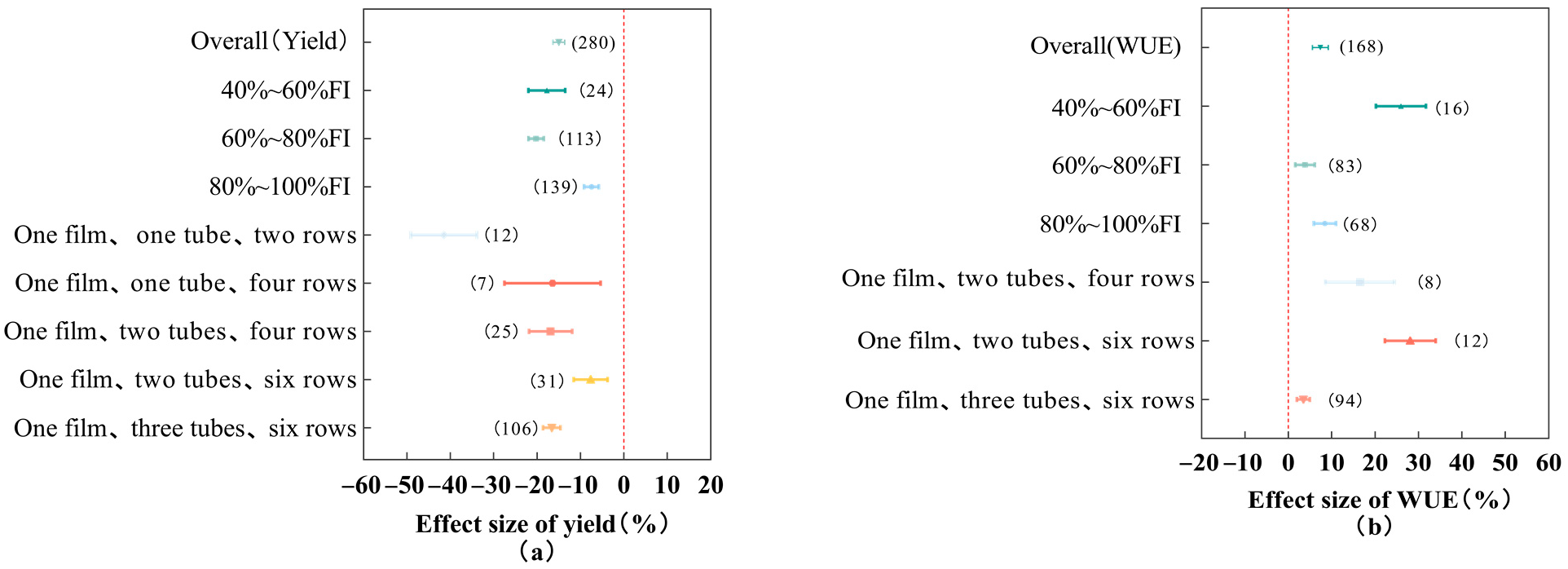
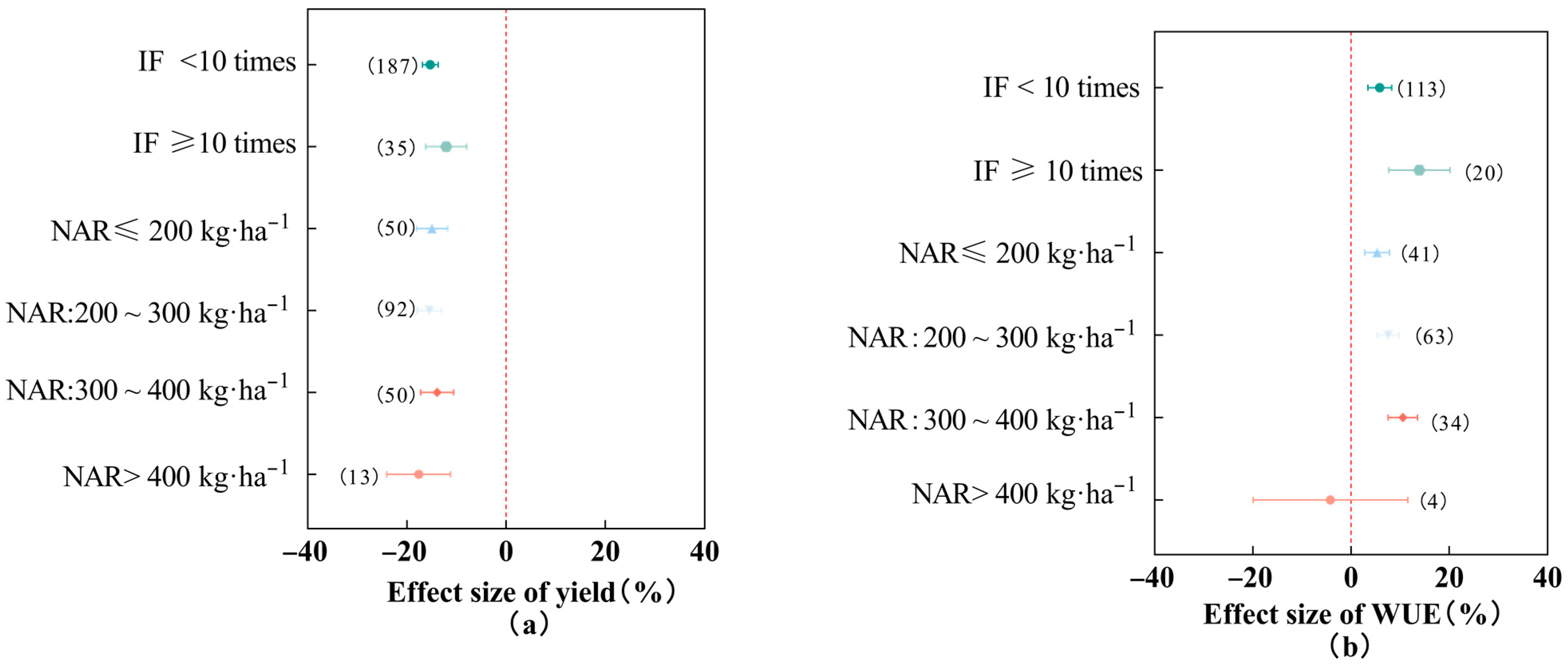
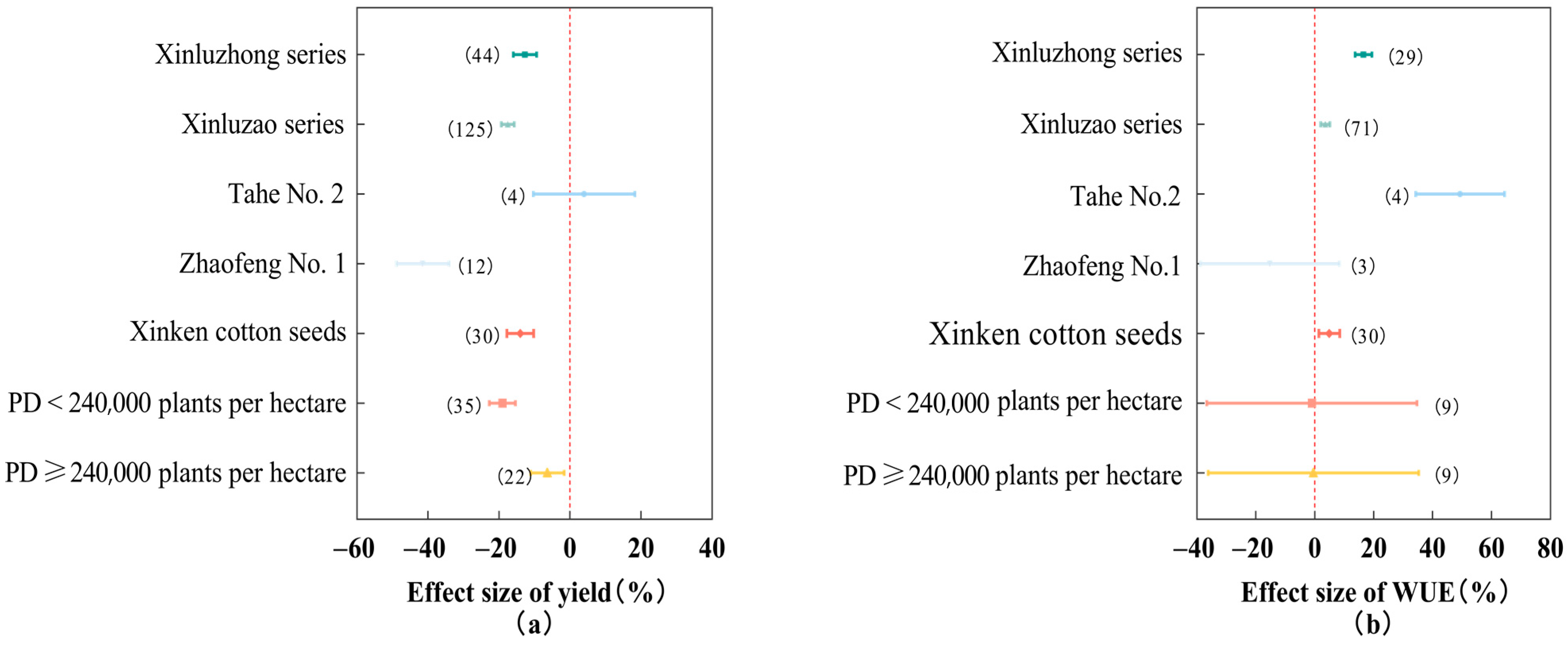
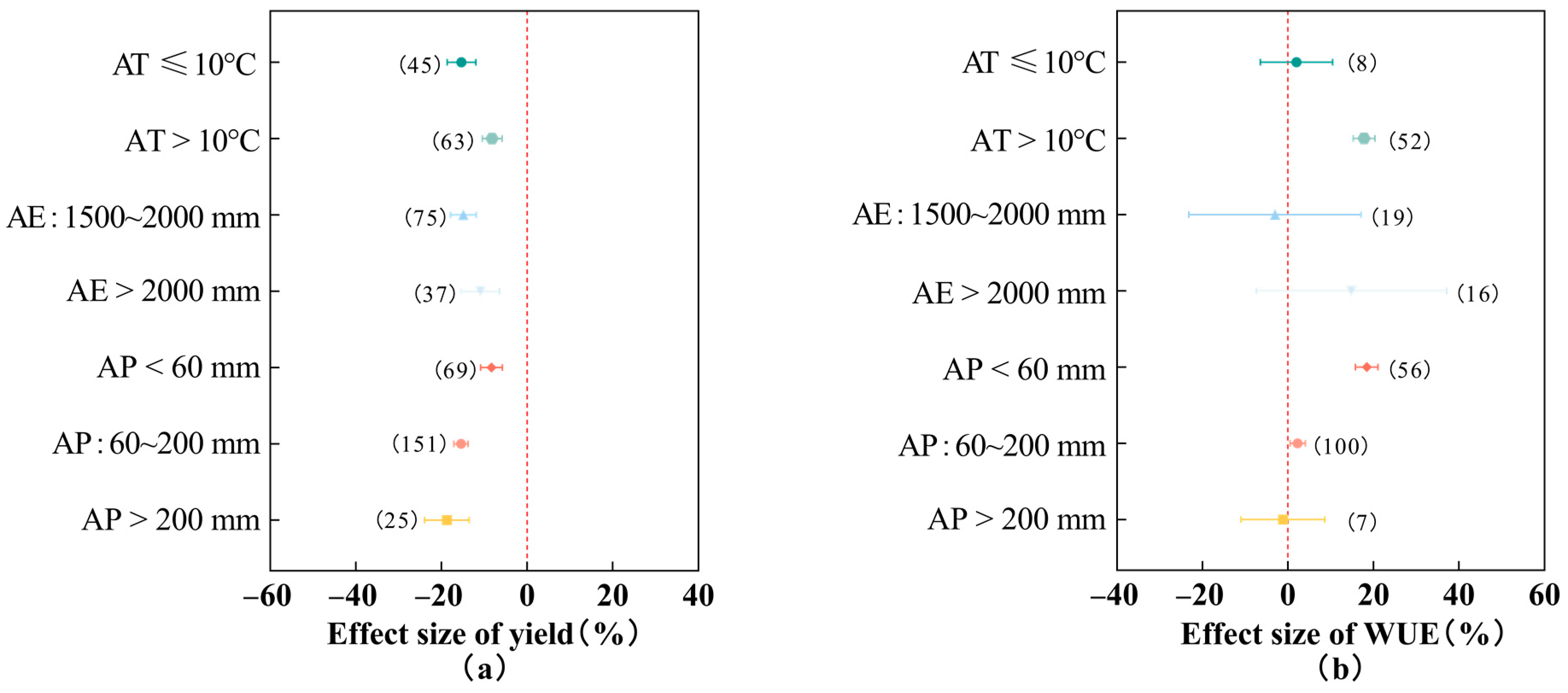
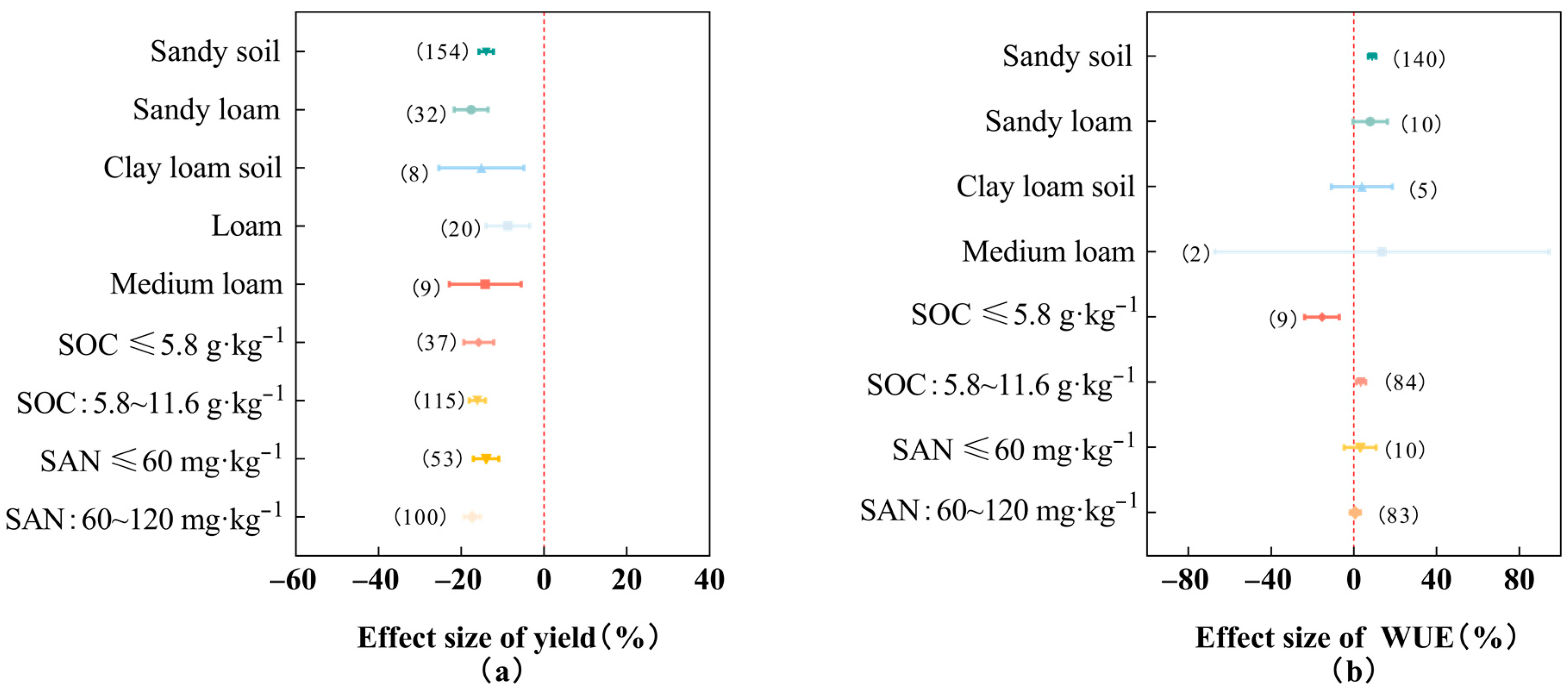


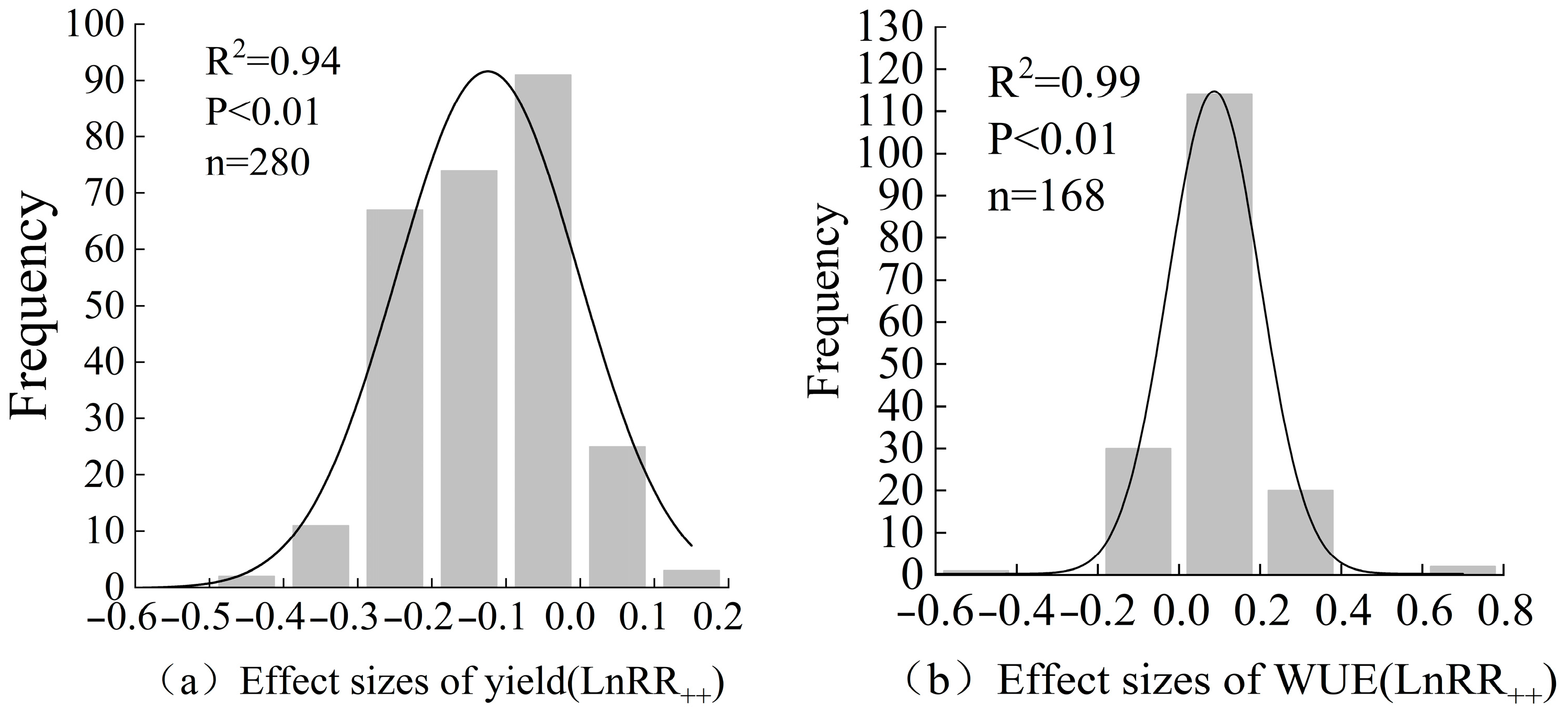
| Impact Factor | Category | Target Zone | Other Zone |
|---|---|---|---|
| Irrigation amount, % | 40~60% FI | 13.33% | 86.67% |
| 60~80% FI | 23.73% | 76.27% | |
| 80~100% FI | 55.74% | 44.26% | |
| Nitrogen application rate, kg·ha−1 | ≤200 | 21.21% | 78.79% |
| 200~300 | 31.25% | 68.75% | |
| 300~400 | 62.07% | 37.93% | |
| >400 | 100% | 0% | |
| Average annual temperature, °C | ≤10 | 50.00% | 50.00% |
| >10 | 58.00% | 42.00% |
| Impact Factor | Category | Effect Value of Cotton Yield | 95% Confidence Interval | Data Sample Size | Mean Effect Size |
|---|---|---|---|---|---|
| Irrigation amount, % | 80~90% FI | −1.23% | −3.53~1.07% | 25 | −0.99% |
| 90~100% FI | −0.16% | −4.86~4.53% | 11 |
| Categorical Variables | Groups |
|---|---|
| Irrigation amount, % | 40~60% FI; 60~80% FI; 80~100% FI |
| Drip tape mode | one film, one tube, two rows; one film, one tube, four rows; one film, two tubes, four rows; one film, two tubes, six rows; one film, three tubes, six rows |
| Irrigation frequency, times | <10; ≥10 |
| Nitrogen application rate, kg·ha−1 | ≤200; 200~300; 300~400; >400 |
| Variety | Xinluzhong series; Xinluzao series; Tahe No. 1; Zhao feng No. 2; Xinken cotton seeds |
| Planting density, plants·ha−1 | <240,000; ≥240,000 |
| Annual temperature, °C | ≤10; >10 |
| Annual evaporation, mm | 1500~2000; >2000 |
| Annual precipitation, mm | <60; 60~200; >200 |
| Soil texture | Sandy soil; Sandy loam; Loam; Clay loam soil; Medium loam |
| Soil organic carbon, g·kg−1 | ≤5.8; 5.8~11.6 |
| Soil available nitrogen, mg·kg−1 | ≤60; 60~120 |
Disclaimer/Publisher’s Note: The statements, opinions and data contained in all publications are solely those of the individual author(s) and contributor(s) and not of MDPI and/or the editor(s). MDPI and/or the editor(s) disclaim responsibility for any injury to people or property resulting from any ideas, methods, instructions or products referred to in the content. |
© 2024 by the authors. Licensee MDPI, Basel, Switzerland. This article is an open access article distributed under the terms and conditions of the Creative Commons Attribution (CC BY) license (https://creativecommons.org/licenses/by/4.0/).
Share and Cite
Xu, Q.; Dong, X.; Huang, W.; Li, Z.; Huang, T.; Song, Z.; Yang, Y.; Chen, J. Evaluating the Effect of Deficit Irrigation on Yield and Water Use Efficiency of Drip Irrigation Cotton under Film in Xinjiang Based on Meta-Analysis. Plants 2024, 13, 640. https://doi.org/10.3390/plants13050640
Xu Q, Dong X, Huang W, Li Z, Huang T, Song Z, Yang Y, Chen J. Evaluating the Effect of Deficit Irrigation on Yield and Water Use Efficiency of Drip Irrigation Cotton under Film in Xinjiang Based on Meta-Analysis. Plants. 2024; 13(5):640. https://doi.org/10.3390/plants13050640
Chicago/Turabian StyleXu, Qi, Xiaomei Dong, Weixiong Huang, Zhaoyang Li, Tongtong Huang, Zaijin Song, Yuhui Yang, and Jinsai Chen. 2024. "Evaluating the Effect of Deficit Irrigation on Yield and Water Use Efficiency of Drip Irrigation Cotton under Film in Xinjiang Based on Meta-Analysis" Plants 13, no. 5: 640. https://doi.org/10.3390/plants13050640






